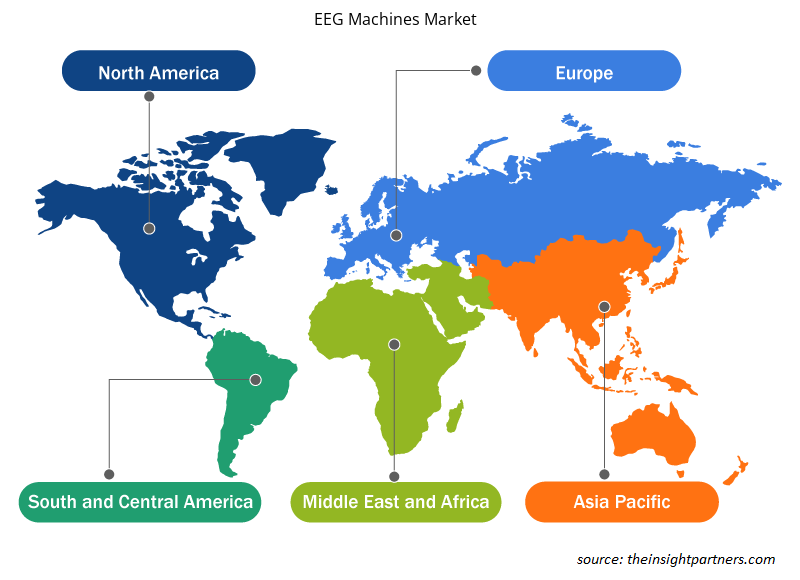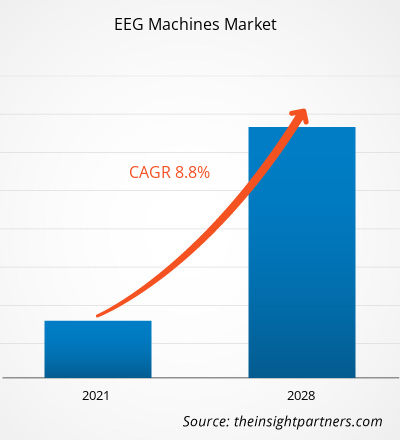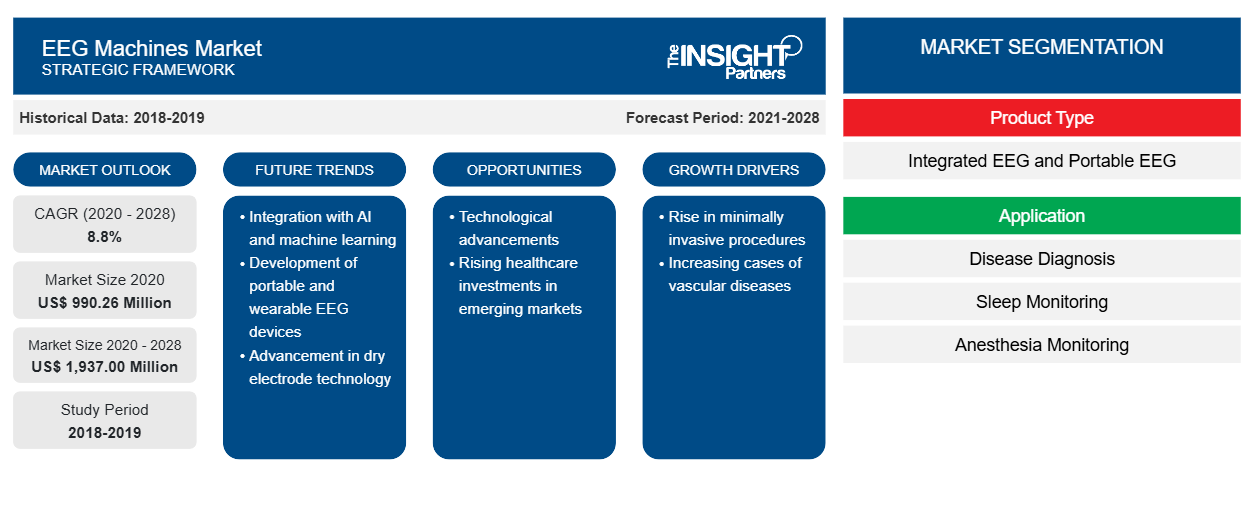[Informe de investigación] El mercado de máquinas EEG se valoró en US$ 990,26 millones en 2020 y se proyecta que alcance los US$ 1.937,00 millones para 2028; se espera que crezca a una CAGR del 8,8% entre 2021 y 2028.
Un electroencefalógrafo (EEG) es un dispositivo médico que ayuda a los profesionales médicos a controlar las señales eléctricas del cerebro. Las señales eléctricas transmitidas son relativamente débiles y, por lo tanto, requieren amplificación. Se utiliza un amplificador para aumentar el voltaje. Las lecturas de un dispositivo de EEG se utilizan para diagnosticar diversos trastornos neurológicos y controlar los trastornos del sueño y a los pacientes bajo anestesia durante procedimientos médicos como la cirugía. El equipo funciona con la ayuda de electrodos adheridos al cuero cabelludo para recopilar la lectura de las ondas cerebrales. El equipo de EEG se utiliza principalmente en hospitales, laboratorios de diagnóstico y centros de cirugía ambulatoria.
El mercado de las máquinas de EEG está segmentado en función del tipo de producto, la aplicación, el usuario final y la geografía. Según la geografía, el mercado está segmentado en América del Norte, Europa, Asia Pacífico, Oriente Medio y África, y América del Sur y Central. El informe ofrece información y un análisis en profundidad del mercado de las máquinas de EEG haciendo hincapié en varios parámetros, como las tendencias del mercado, los avances tecnológicos, la dinámica del mercado y el análisis del panorama competitivo de los principales actores del mercado en todo el mundo. También incluye un análisis del impacto de COVID-19 en todas las regiones. Se estima que es probable que el mercado tenga una tasa de crecimiento más lenta durante el período de pronóstico debido a los servicios de salud restringidos y la situación de bloqueo causada por la pandemia de COVID-19.
Personalice este informe según sus necesidades
Obtendrá personalización en cualquier informe, sin cargo, incluidas partes de este informe o análisis a nivel de país, paquete de datos de Excel, así como también grandes ofertas y descuentos para empresas emergentes y universidades.
-
Obtenga las principales tendencias clave del mercado de este informe.Esta muestra GRATUITA incluirá análisis de datos, desde tendencias del mercado hasta estimaciones y pronósticos.
Perspectivas del mercado
Aumento de los trastornos neurológicos
La incidencia de trastornos neurológicos está aumentando entre las personas mayores. Sin embargo, debido a diversos factores como el estrés, las mutaciones genéticas, los hábitos de vida y las enfermedades crónicas relacionadas, la incidencia se observa entre personas de todos los grupos de edad. Se estima que existen más de 600 trastornos neurológicos, entre los que se encuentran el Parkinson, el Huntington, el Alzheimer, la distrofia muscular, los accidentes cerebrovasculares, la meningitis, la epilepsia, las demencias, la migraña y los tumores cerebrales.
Según el informe Global Burden of Disease, publicado en JAMA Neurology 2017, en Estados Unidos se estudiaron los años de vida ajustados por discapacidad (AVAD) de las enfermedades más graves, como el ictus, la migraña, la enfermedad de Alzheimer y otras demencias. Los AVAD para el ictus fueron de 3,58 millones, para la enfermedad de Alzheimer y otras demencias de 2,55 millones, y para la migraña de 2,4 millones. Se estima que es probable que la incidencia aumente en el futuro, con la tasa de incidencia de la meningitis (44,8%), la lesión cerebral traumática (44,8%), la lesión de la médula espinal (29,1%) y la encefalitis (38,5%).
De manera similar, se espera que la creciente población geriátrica influya en la incidencia de trastornos neurológicos. Según el informe de la Organización Mundial de la Salud (OMS) publicado en 2018, la población total mayor de 60 años crecerá a una tasa del 22% para 2050 desde el 12% en 2015. Según el Foro Interinstitucional Federal sobre Estadísticas Relacionadas con el Envejecimiento publicado en 2016, el 35,8% de las personas de 85 años o más tienen deterioro moderado o grave de la memoria. Por lo tanto, debido a las estadísticas mencionadas anteriormente, se espera que aumente la demanda de máquinas de EEG, lo que, a su vez, impulsará el crecimiento del mercado.
Información basada en el tipo de producto
Según el tipo de producto, el mercado de los equipos de EEG se segmenta en EEG integrados y EEG portátiles. El segmento de EEG integrados tuvo la mayor participación del mercado en 2020, sin embargo, se prevé que el segmento de EEG portátiles registre la CAGR más alta del mercado durante el período de pronóstico. El crecimiento del segmento de EEG portátiles se puede atribuir a los avances tecnológicos que ofrecen actividad cerebral en tiempo real, que es relativamente económica y no invasiva.
Perspectivas basadas en aplicaciones
Según la aplicación, el mercado de las máquinas de EEG se segmenta en diagnóstico de enfermedades, monitorización del sueño, monitorización de la anestesia, traumatología y cirugía, entre otros. El segmento de diagnóstico de enfermedades tuvo la mayor participación del mercado en 2020; además, se prevé que el segmento registre la CAGR más alta del mercado durante el período de pronóstico.
Información basada en el usuario final
Según el usuario final, el mercado de las máquinas de EEG se segmenta en hospitales, centros de diagnóstico, centros de cirugía ambulatoria, laboratorios de investigación y otros. El segmento de hospitales tuvo la mayor participación del mercado en 2020, sin embargo, se prevé que el segmento de centros de diagnóstico registre la CAGR más alta del mercado durante el período de pronóstico.
Los actores del mercado adoptaron estrategias orgánicas e inorgánicas por igual para satisfacer la cambiante demanda de los clientes y mantener sus servicios mejorados. Por ejemplo, Fresenius Kabi adoptó una estrategia orgánica de expansión en febrero de 2021. La empresa invirtió en mejoras en sus instalaciones en todo el mundo para ayudar en la atención de pacientes con enfermedades graves y crónicas, de acuerdo con la filosofía de la empresa de cuidar la vida. Además, Fresenius Kabi siguió invirtiendo en sus dos instalaciones de Graz.
Perspectivas regionales del mercado de máquinas de EEG
Los analistas de Insight Partners explicaron en detalle las tendencias y los factores regionales que influyen en el mercado de las máquinas de EEG durante el período de pronóstico. Esta sección también analiza los segmentos y la geografía del mercado de las máquinas de EEG en América del Norte, Europa, Asia Pacífico, Oriente Medio y África, y América del Sur y Central.

- Obtenga datos regionales específicos para el mercado de máquinas de EEG
Alcance del informe de mercado de máquinas de EEG
| Atributo del informe | Detalles |
|---|---|
| Tamaño del mercado en 2020 | US$ 990,26 millones |
| Tamaño del mercado en 2028 | US$ 1.937,00 millones |
| Tasa de crecimiento anual compuesta (CAGR) global (2020-2028) | 8,8% |
| Datos históricos | 2018-2019 |
| Período de pronóstico | 2021-2028 |
| Segmentos cubiertos |
Por tipo de producto
|
| Regiones y países cubiertos |
América del norte
|
| Líderes del mercado y perfiles de empresas clave |
|
Densidad de actores del mercado de máquinas de EEG: comprensión de su impacto en la dinámica empresarial
El mercado de máquinas de electroencefalografía está creciendo rápidamente, impulsado por la creciente demanda de los usuarios finales debido a factores como la evolución de las preferencias de los consumidores, los avances tecnológicos y una mayor conciencia de los beneficios del producto. A medida que aumenta la demanda, las empresas amplían sus ofertas, innovan para satisfacer las necesidades de los consumidores y aprovechan las tendencias emergentes, lo que impulsa aún más el crecimiento del mercado.
La densidad de actores del mercado se refiere a la distribución de las empresas o firmas que operan dentro de un mercado o industria en particular. Indica cuántos competidores (actores del mercado) están presentes en un espacio de mercado determinado en relación con su tamaño o valor total de mercado.
Las principales empresas que operan en el mercado de máquinas EEG son:
- Philips NV, la línea Koninklijke
- Medtronic
- Natus Medical Incorporated
- Corporación Nihon Kohden
- Fresenius SE & Co. KGaA
Descargo de responsabilidad : Las empresas enumeradas anteriormente no están clasificadas en ningún orden particular.

- Obtenga una descripción general de los principales actores clave del mercado de máquinas EEG
Por tipo de producto
- EEG integrado
- EEG portátil
Por aplicación
- Diagnóstico de enfermedades
- Monitoreo del sueño
- Monitoreo de anestesia
- Trauma y cirugía
- Otros
Por el usuario final
- Hospitales
- Centros de diagnóstico
- Centros de cirugía ambulatoria
- Laboratorios de investigación
- Otros
Por geografía
-
América del norte
- A NOSOTROS
- Canadá
- México
-
Europa
- Francia
- Alemania
- Italia
- Reino Unido
- España
- Resto de Europa
-
Asia Pacífico (APAC)
- Porcelana
- India
- Corea del Sur
- Japón
- Australia
- Resto de APAC
-
Oriente Medio y África (MEA)
- Sudáfrica
- Arabia Saudita
- Emiratos Árabes Unidos
- Resto de MEA
-
América del Sur y Central (SCAM)
- Brasil
- Argentina
- Resto de estafa
Perfiles de empresas
- Philips NV, la línea Koninklijke
- Medtronic
- Natus Medical Incorporated
- Corporación Nihon Kohden
- Fresenius SE & Co. KGaA
- Monitorización cerebral avanzada
- EXPLOTACIONES D & DJ BURTON
- Cefalon A/S
- Industrias Cadwell Inc.,
- NeuroStyle Ptd. Limitada.
- Análisis histórico (2 años), año base, pronóstico (7 años) con CAGR
- Análisis PEST y FODA
- Tamaño del mercado, valor/volumen: global, regional y nacional
- Industria y panorama competitivo
- Conjunto de datos de Excel
Informes recientes
Informes relacionados
Testimonios
Razón para comprar
- Toma de decisiones informada
- Comprensión de la dinámica del mercado
- Análisis competitivo
- Información sobre clientes
- Pronósticos del mercado
- Mitigación de riesgos
- Planificación estratégica
- Justificación de la inversión
- Identificación de mercados emergentes
- Mejora de las estrategias de marketing
- Impulso de la eficiencia operativa
- Alineación con las tendencias regulatorias























 Obtenga una muestra gratuita para - Mercado de máquinas de EEG
Obtenga una muestra gratuita para - Mercado de máquinas de EEG